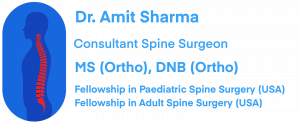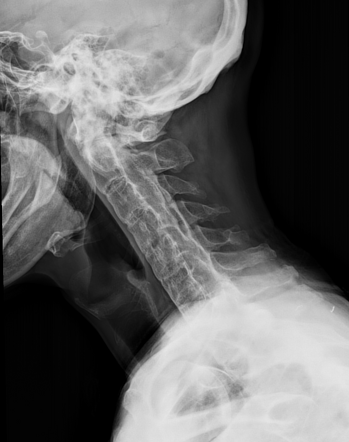Best Spine Surgeon in Mumbai | Dr. Amit Sharma

+91-9967600461
draks777@gmail.com
Ankylosing Spondylitis and Spine

Ankylosing Spondylitis and Spine
Ankylosing Spondylitis and the Spine
Ankylosing spondylitis (AS) is a chronic inflammatory arthritis that primarily affects the spine. It’s essential for patients to understand this condition, its impact on the spine, and how to manage it effectively. In this comprehensive guide, we will delve into the world of ankylosing spondylitis and explore its intricate relationship with the spine, spinal fractures, spinal fusion, and the potential need for spine surgery to address deformities.
What is Ankylosing Spondylitis?
Ankylosing spondylitis is a form of spondyloarthritis, a group of autoimmune diseases that primarily target the spine and adjacent structures. It is characterized by inflammation of the joints between the vertebrae and the sacroiliac joints, leading to pain, stiffness, and potentially, spinal fusion.
The Spine’s Role in Ankylosing Spondylitis
The spine is a complex structure composed of 33 vertebrae that are responsible for supporting the upper body and enabling movement. When AS strikes, it often targets the lower back and sacroiliac joints, causing inflammation in the affected areas. Over time, this inflammation can lead to structural damage, particularly in the following ways:
1. Sacroiliac Joint Inflammation:
- The sacroiliac joints connect the sacrum (the triangular bone at the base of the spine) to the ilium (the pelvic bone). Inflammation in these joints is a hallmark of AS and can cause significant pain, especially in the lower back and buttocks.
2. Vertebral Inflammation:
- In AS, inflammation can occur at the points where ligaments and tendons attach to the vertebrae, particularly in the lumbar (lower) and thoracic (middle) regions of the spine. This inflammation can lead to pain, stiffness, and eventual fusion of the spine.
3. Spinal Fusion:
- One of the most notable features of AS is the potential for spinal fusion. As inflammation persists, the body’s natural response is to heal the damaged areas by forming new bone. Over time, this process can lead to the fusion of the vertebrae, resulting in a loss of spinal mobility.
Symptoms and Diagnosis of Ankylosing Spondylitis
AS can present a wide range of symptoms, including chronic pain, morning stiffness, fatigue, and reduced flexibility. The diagnosis of AS often involves a combination of medical history, physical examination, imaging studies (like X-rays and MRI scans), and blood tests to detect specific markers associated with inflammation.
Treatment and Management of Ankylosing Spondylitis
While there is no cure for AS, the condition can be effectively managed with a variety of treatment options:
1. Medications:
- Nonsteroidal anti-inflammatory drugs (NSAIDs) can help reduce pain and inflammation. For more severe cases, disease-modifying antirheumatic drugs (DMARDs) or biologics may be prescribed to slow the progression of the disease.
2. Physical Therapy:
- Physical therapy can help improve flexibility, posture, and overall spinal health. Specific exercises are designed to strengthen the muscles supporting the spine.
3. Lifestyle Adjustments:
- Maintaining good posture, regular exercise, and avoiding smoking can significantly benefit those with AS.
4. Surgery:
- In rare cases where severe spinal deformity or pain persists, surgery may be considered. Procedures such as spinal fusion can help correct deformities and alleviate pain.
The Importance of Early Intervention in AS
Early diagnosis and treatment are crucial for managing AS effectively and minimizing spinal damage. Timely intervention can help reduce pain, maintain spinal flexibility, and prevent or delay the fusion of the spine.
Embracing a Full Life with AS
It’s important for individuals living with AS to remember that the condition doesn’t define them. With the right approach to treatment, lifestyle adjustments, and support from healthcare professionals, many people with AS can lead fulfilling and active lives.
Understanding Ankylosing Spondylitis and Spinal Fusion
AS is a condition that predominantly targets the spine. Inflammation in the spinal joints and ligaments can lead to the fusion of adjacent vertebrae. This fusion can be both a coping mechanism for the body to stabilize the spine and a source of discomfort as it limits spinal mobility.
Over time, the fusion can result in the development of a stiff, inflexible spine. While fusion can be an effective way to reduce pain associated with AS, it comes with its own set of challenges.
Spinal Fractures in Ankylosing Spondylitis
One of the significant concerns related to AS is the increased risk of spinal fractures. The fused, inflexible spine becomes brittle and more susceptible to fractures, particularly after even minor trauma or a fall. These fractures can be painful and debilitating, requiring immediate medical attention.
The treatment for AS-related spinal fractures may involve rest, bracing, or in severe cases, surgery. In some instances, spinal fractures may necessitate the need for spine surgery to stabilize the spine and prevent further damage.
Spinal Deformities and Their Impact
As AS progresses and fusion occurs, the spine can take on an abnormal posture. This can lead to the development of spinal deformities, such as kyphosis or a “forward stoop,” which significantly affects a person’s quality of life. Deformities may limit a person’s ability to perform daily activities, affect breathing, and cause chronic pain.
The Role of Spine Surgery
In cases where AS leads to significant spinal deformities or posture-related issues, spine surgery may be considered. The goal of surgery is to correct these deformities, improve posture, and enhance the patient’s overall quality of life. There are several surgical approaches for addressing spinal deformities related to AS:
1. Osteotomy:
This surgical procedure involves cutting and realigning the vertebrae to correct deformities and improve posture.
2. Spinal Fusion:
In some cases, where the deformity is severe, fusion may be necessary to stabilize the spine after osteotomy.
3. Spine Implantation:
Surgeons may use implants, such as rods and screws, to provide additional support and stability to the spine.
4. Spine Decompression:
For patients with spinal cord compression due to deformities, decompression surgeries can help relieve pressure on the spinal cord.
Post-Surgery Recovery and Rehabilitation
Recovery from spine surgery for AS-related spinal deformities involves a structured rehabilitation program. Physical therapy and exercises are essential to help regain mobility, strength, and flexibility. The rehabilitation process is tailored to each patient’s specific needs and typically continues for an extended period to ensure a successful outcome.
Hello,
This Information is helpful to understand about treatment & Management of Ankylosing Spondylitis and the Spine.
Thank you.